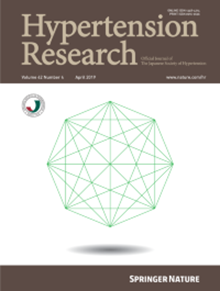原发性醛固酮增多症患者中卡托普利挑战试验定义的明确阳性组和边缘范围组之间靶器官损伤的差异。
IF 4.3
2区 医学
Q1 PERIPHERAL VASCULAR DISEASE
引用次数: 0
摘要
日本关于原发性醛固酮增多症的新指南在功能确证试验的判断中引入了一个被称为 "边缘范围 "的类别,这在其他国际指南中并不多见。目前尚不清楚这一边缘群体的临床特征。为了研究这一边缘组在靶器官损害方面是否存在显著差异,我们使用了日本全国范围内原发性醛固酮增多症或原发性高血压患者的登记数据(JPAS-II),将边缘组与确诊阳性组和阴性组进行了比较。我们根据卡托普利挑战试验结果分析了 1785 名患者的病例。由于 JPAS-II 数据库包含根据放射免疫分析(n = 1555)和化学发光酶免疫分析(n = 230)原理获得的血浆醛固酮浓度值,因此我们将这些值转换为等效的化学发光酶免疫分析值,并在模拟条件下进行了所有分析。多变量调整模型显示,慢性肾病(2.01,95% 置信区间:1.13 至 3.61)、心电图异常(1.66,95% 置信区间:1.16 至 2.37)的患病几率比较大。在这些评估中,边缘组和阴性组之间没有观察到明显的差异(慢性肾病的几率比[95% 置信区间]为 0.73 [0.26 至 2.37]):0.73 [0.26 至 2.02] 和心电图异常:1.01 [0.60 至 1.70])。我们证实,随着卡托普利挑战试验后醛固酮-肾素比值的升高,靶器官损伤的发生率呈线性增加。这些结果为考虑暂时确定的边界组的意义提供了材料。本文章由计算机程序翻译,如有差异,请以英文原文为准。

Differences in target organ damage between captopril challenge test-defined definitive-positive and borderline-range groups among patients with primary aldosteronism
The new Japanese guidelines for primary aldosteronism introduce a category in the judgment of functional confirmatory tests that is called the “borderline range,” which is rare in the other international guidelines. The clinical characteristics of this borderline group are not yet understood. To investigate whether this borderline group has any significant differences in terms of target organ damage, we used data from a Japanese nationwide registry (JPAS-II) of individuals with primary aldosteronism or essential hypertension to compare the borderline group with the definitive-positive group and the negative group. We analyzed the cases of 1785 patients based on their captopril-challenge test results. Since the JPAS-II database contains plasma aldosterone concentration values obtained based on both radioimmunoassay (n = 1555) and chemiluminescent enzyme immunoassay (n = 230) principles, we converted these values to their equivalents as if measured by chemiluminescent enzyme immunoassay and conducted all analyses under the simulated condition. Multicovariate-adjusted models revealed significant prevalance odds ratios for chronic kidney disease (2.01, 95% confidence interval: 1.13 to 3.61), electrocardiographic abnormalities (1.66, 95% confidence interval: 1.16 to 2.37). No significant difference was observed between the borderline and negative groups in these assessments (odds ratio [95% confidence interval] for chronic kidney disease: 0.73 [0.26 to 2.02] and electrocardiographic abnormalities: 1.01 [0.60 to 1.70]). We confirmed that the prevalence of target organ damage increases linearly as the aldosterone-to-renin ratio rises following the captopril challenge test. These results provide material to consider regarding the significance of the provisionally established borderline group.
求助全文
通过发布文献求助,成功后即可免费获取论文全文。
去求助
来源期刊

Hypertension Research
医学-外周血管病
CiteScore
7.40
自引率
16.70%
发文量
249
审稿时长
3-8 weeks
期刊介绍:
Hypertension Research is the official publication of the Japanese Society of Hypertension. The journal publishes papers reporting original clinical and experimental research that contribute to the advancement of knowledge in the field of hypertension and related cardiovascular diseases. The journal publishes Review Articles, Articles, Correspondence and Comments.
 求助内容:
求助内容: 应助结果提醒方式:
应助结果提醒方式:


